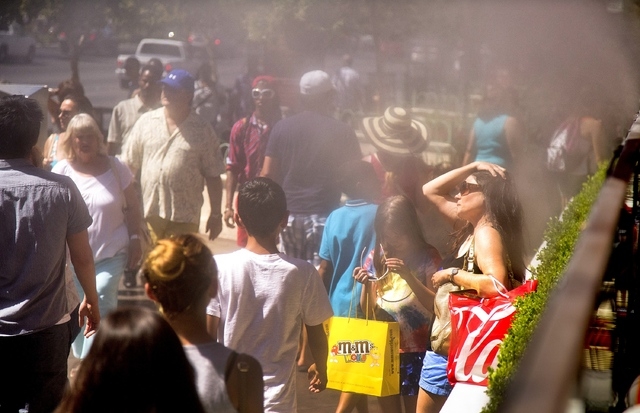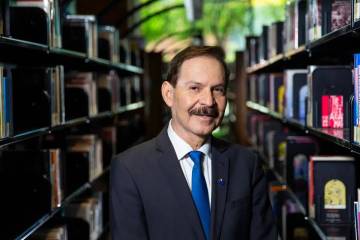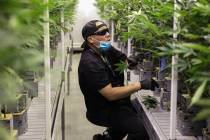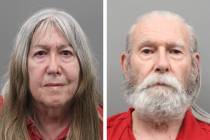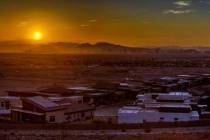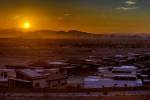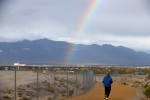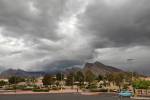Analysis: Las Vegas getting hotter faster than most other cities
Las Vegas is getting hot fast.
The city is known for its sweltering summers, but according to an Associated Press analysis of federal temperatures released Wednesday, the valley has the fifth-largest average temperature increase.
Carson City, the state’s capital, took the nation’s top spot with an increase of 4.1 degrees since 1984.
The valley’s 3.4-degree increase has been heavily influenced by its rapid urbanization, National Weather Service meteorologist Dan Berk said.
“The last time we recorded a record low temperature on any given day was June 4, 15 years ago,” Berk said. “That’s a testament to that rapid expansion.”
As the city swells, more roads are paved with asphalt and more buildings are erected. Berk said these materials absorb the heat of the sun throughout the day and retain it throughout the night, creating a heat island effect that sustains the valley’s high temperatures and gradually increases its lows.
“Las Vegas is not a good place to assess global warming because our high temperatures are not really indicative of global warming as much as they are indicative of rapid urbanization,” Berk said on a day that reached 102 degrees. A high of 107 degrees is expected Sunday.
As temperatures climb, residents are reaching out to local air conditioning businesses to keep their homes cool. Michelle Rayburn said her family’s business, SunCountry Heating &Cooling, sees an increase in calls each summer.
“You can live without heat in Vegas, but you can’t live without air,” Rayburn said. “In the last three weeks there’s been calls for upgraded and more efficient units every day.”
Carson City’s warming is similar, the AP report said. Nestled in a valley at the base of the Carson Range, the city is ringed by hills and mountains.
And as the city has grown, more roads, asphalt, homes and commercial development — ingredients for heat absorption and urban warming — have cropped up.
In 1984, about 35,000 people lived there, and today the population is 55,000, according to government records. Instead of fields and meadows, there are houses and commercial complexes.
David Ruf of Greenhouse Garden Center in Carson City was surprised by the amount of warming that has occurred but not by the warming itself.
Ruf, whose father started the business 40 years ago, keeps meticulous weather records.
“When we started here, usually there was a temperature swing between night and day of 45 degrees,” Ruf said. “Now we seem to be 35 degrees.”
To determine what parts of the country have warmed the most, The Associated Press analyzed National Climatic Data Center temperature trends in the lower 48 states, 192 cities and 344 smaller regions within the states. Climate scientists suggested 1984 as a starting date because 30 years is a commonly used time period and 1984, which had an average temperature, is not a cherry-picked year to skew a trend either way. The trend was calculated by the climate center using the least squares regression method, which is a standard statistical tool.
Carson City and Boise, Idaho, are the cities that have seen the most warming — both year-round and in summer — since 1984. Both cities’ average annual temperatures have jumped more than 4 degrees in just 30 years, while Dickinson, N.D., has dropped the most, a bit more than 2 degrees.
The change in Carson City is becoming noticeable in subtle ways.
Plants and trees are prone to bloom earlier, and more people are installing air conditioners. The systems were a rarity even a decade ago, when many residents didn’t want to spend the money when only a couple of weeks in August seemed insufferable.
Sam Lompa, who lives on a ranch in the heart of Carson City, feels the warming effects.
“When I was a kid, we never had any air conditioners,” said Lompa, 71, who grew up on the ranch. Now he uses fans and a swamp cooler but doesn’t fret much about the temperature.
“If it’s hot, it’s hot, and if it’s cold, it’s cold,” he said.
Ruf, too, is skeptical of putting too much emphasis on temperature shifts, though this May seemed unusually warm, with temperatures in the 80s.
“Every time I say it’s getting hotter, the next year gets colder,” Ruf said. “Mother Nature can still pack a wallop.”
The Associated Press contributed to this report. Contact Rachel Crosby at rcrosby@reviewjournal.com or 702-380-5290.





